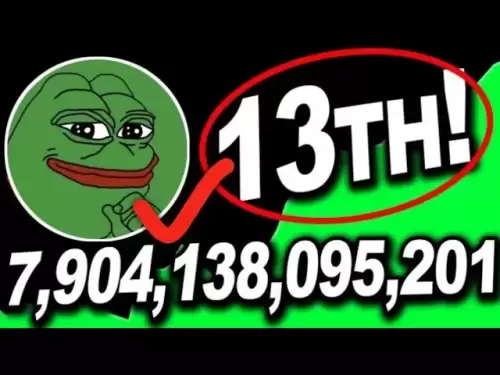 |
|
 |
|
 |
|
 |
|
 |
|
 |
|
 |
|
 |
|
 |
|
 |
|
 |
|
 |
|
 |
|
 |
|
 |
|
Cryptocurrency News Articles
In early April 2025, the United States dramatically ramped up reciprocal tariffs on Chinese imports
Apr 21, 2025 at 01:20 am
In early April 2025, the United States dramatically ramped up reciprocal tariffs on Chinese imports—culminating in an across‑the‑board 125 percent duty—while China struck back

Early April 2025 saw the U.S. dramatically ramp up reciprocal tariffs on Chinese imports, culminating in an across-the-board 125 percent duty, while China retaliated with matching levies on U.S. goods. Simultaneously, the U.S. moved to close the ‘de minimis’ loophole, subjecting low-value parcels (under $800) to steep duties starting May 2, 2025.
These actions are part of Executive Order 14257, declared a national emergency to address persistent trade deficits. As industries scramble to mitigate costs—stockpiling inventory in U.S. warehouses and rerouting supply chains—both sides have signaled potential de-escalation. President Trump hinted he may refrain from further hikes amid concerns over consumer spending, and China has indicated it will not raise tariffs beyond 125 percent.
The Trade War Heats Up: April 2025 Tariffs
In a surprising move, President Trump announced on April 2 that he was taking the "drastic step" of imposing a reciprocal tariff of 125 percent on all imports from China, in response to China's tariffs on U.S. products. The order, codified in Executive Order 14257, also closed the de minimis exemption for packages valued under $800, subjecting them to a 120 percent ad valorem tariff or a $100 per-package fee, which rises to $200 by June 1.
The move was met with mixed reactions. Some economists praised the administration for finally taking action to address the trade deficit, which they said had been a major drag on the U.S. economy. Others warned that the tariffs would ultimately harm consumers and businesses, and could lead to a trade war.
The administration also announced that it was granting a six-month reprieve to several types of semiconductor equipment from the new tariffs, in response to appeals from the industry. The move was seen as a sign that the administration was willing to listen to feedback and make adjustments to its policies.
As the world's two largest economies locked horns in a trade war on Thursday, China said it would continue to buy U.S. products despite the difficulties, and it had no plans to increase tariffs beyond the 125 percent levied in retaliation for new U.S. tariffs.
"We have no intention to escalate the tariffs further," a spokesperson for the State Council Tariff Commission told a press conference on Thursday. "We will continue to purchase U.S. products according to the agreement reached by the heads of state of the two countries."
The spokesperson's comments came after the U.S. announced new tariffs on Thursday, including a 125 percent reciprocal tariff on all Chinese imports and the closure of the de minimis exemption for packages valued under $800. The move is part of President Trump's effort to reduce the U.S. trade deficit with China, which reached a 15-year high of $419 billion in 2024.
The administration said the new tariffs were necessary to counter unfair trade practices by China, such as forced technology transfer and intellectual property theft. It also said the tariffs were needed to protect U.S. jobs and industries from Chinese competition.
The Chinese government responded in kind to the U.S. measures, announcing identical retaliatory tariffs on Thursday. The State Council Tariff Commission said in a statement that the new tariffs would take effect on May 2.
The new tariffs will apply to a wide range of U.S. products, including agricultural goods, automobiles, and energy products. The tariffs are also designed to hit industries that are important to President Trump's political base, such as soybeans and copper.
The move to close the de minimis exemption will also have a significant impact on U.S. consumers, who will now have to pay tariffs on all packages from China, regardless of value. The exemption had previously applied to packages valued under $800, but the new measure reduces the threshold to $100 for packages arriving before June 1 and $200 for packages arriving after that date.
The administration said the change was necessary to prevent Chinese e-commerce companies, such as Shein and Temu, from evading tariffs by shipping goods in small packages. The two companies' products accounted for nearly half of the $66 billion in small-parcel e-commerce shipments from China last year.
The administration said it was granting a six-month reprieve to several types of semiconductor equipment from the new tariffs, in response to appeals from the industry. The move was seen as a sign that the administration was willing to listen to feedback and make adjustments to its policies.
The administration said it was postponing the imposition of the new tariffs on semiconductor equipment until November 2, 2025. The extension will apply to
Disclaimer:info@kdj.com
The information provided is not trading advice. kdj.com does not assume any responsibility for any investments made based on the information provided in this article. Cryptocurrencies are highly volatile and it is highly recommended that you invest with caution after thorough research!
If you believe that the content used on this website infringes your copyright, please contact us immediately (info@kdj.com) and we will delete it promptly.
-

- 2025-W Uncirculated American Gold Eagle and Dr. Vera Rubin Quarter Mark New Products
- Jun 13, 2025 at 06:25 am
- The United States Mint released sales figures for its numismatic products through the week ending June 8, offering the first results for the new 2025-W $50 Uncirculated American Gold Eagle and the latest products featuring the Dr. Vera Rubin quarter.
-

-

- H100 Group AB Raises 101 Million SEK (Approximately $10.6 Million) to Bolster Bitcoin Reserves
- Jun 13, 2025 at 06:25 am
- In a significant move reflecting the growing convergence of healthcare technology and digital finance, Swedish health-tech firm H100 Group AB has raised 101 million SEK (approximately $10.6 million) to bolster its Bitcoin reserves.
-

-

-

-

-

-




























































